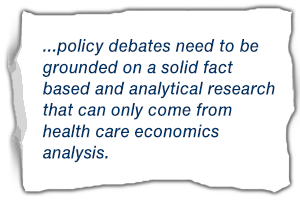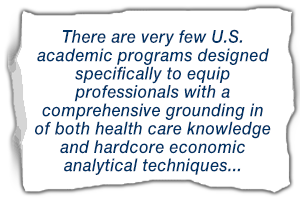
Reynold W. (Pete) Mooney
About a year ago I had an informal meeting with several CEO acquaintances. One worked with a large provider organization, one was from a major life sciences company, and the third was with a health care consulting firm. The conversation turned to the vast transformation occurring in the health care industry. This gets characterized in short hand as the movement towards outcomes and value and we all voiced frustration that describing it this way trivializes what is really an extraordinary seismic shift in thinking. We also concluded that while it was easy to express an idealized endpoint as “outcomes and value”, if we each talked to twenty people we’d end up with eighty definitions of what this really meant and how it would be measured. Finally, we concluded that it was difficult to predict the timing or the route the industry would take to reach this nirvana and that we were only somewhere at the beginning of this journey, despite the hype and noise around it.
We were all struck that the industry is beginning to have the expectation that we will express a value proposition for our products and services measured by better patient outcomes relative to cost. While this expectation is growing, we are all of having difficulty finding resources with the appropriate training in both health care and economics that would equip them to do the hardcore analysis necessary to inform these kinds of propositions.
 To unpack this observation, the old world is fee-for-service. Price and cost is relatively straightforward in this world. You had a medical procedure and here’s how much that cost; you had a hospital stay of two days and here’s how much that cost; you took a pill and here’s how much that cost. We know how to figure out direct costs – manufacturing, materials, direct labor and the like – and how to allocate indirect and overhead costs like marketing, research and development, and other administrative costs to products and services. We impute a profit margin, negotiate with the payer or government health system and, voilà – here’s your price. While not to trivialize the complexity, opacity, difficulty and controversy in this approach, it is based on traditional cost accounting principles that have been around for literally hundreds of years. The analytical tools are well understood.
To unpack this observation, the old world is fee-for-service. Price and cost is relatively straightforward in this world. You had a medical procedure and here’s how much that cost; you had a hospital stay of two days and here’s how much that cost; you took a pill and here’s how much that cost. We know how to figure out direct costs – manufacturing, materials, direct labor and the like – and how to allocate indirect and overhead costs like marketing, research and development, and other administrative costs to products and services. We impute a profit margin, negotiate with the payer or government health system and, voilà – here’s your price. While not to trivialize the complexity, opacity, difficulty and controversy in this approach, it is based on traditional cost accounting principles that have been around for literally hundreds of years. The analytical tools are well understood.
The outcomes world we’re moving towards is quite different. As the word implies, outcomes is focused on results  rather than on “what you did”. A positive outcome in health care is a patient that has a disease or condition cured or managed, whose life span is extended, or whose quality of life is in some way improved – at some societally acceptable cost. This is much more complex than determining the cost of a product or service since the outcome is impacted by many variables, some of which can be quite subjective. To determine a good value proposition based on outcome a whole new bag of economic tools is required. It takes the application of a number of advanced economic concepts such as utility theory, behavioral economics, and game theory.
rather than on “what you did”. A positive outcome in health care is a patient that has a disease or condition cured or managed, whose life span is extended, or whose quality of life is in some way improved – at some societally acceptable cost. This is much more complex than determining the cost of a product or service since the outcome is impacted by many variables, some of which can be quite subjective. To determine a good value proposition based on outcome a whole new bag of economic tools is required. It takes the application of a number of advanced economic concepts such as utility theory, behavioral economics, and game theory.
In practice, outcomes analysis requires making complex and explicit trade-offs, often implying moral or ethical judgments. For instance, how would you trade-off living five extra years, but with a certain level of pain, compared to living three additional years pain free? The details matter. How much pain? Where? If it was just pain in my knee I could take that for 5 years, but a constant headache? Two years max. Would I be bed-ridden for those 5 years, or able to get around and do things? What if the cost of getting those five years was exorbitant? Should the health system pay or decide it is not cost effective from a societal point of view? Is it acceptable that wealthy individuals pay out-of-pocket while the less affluent go without? The questions can go on and on. The discussion around issues like this is right and absolutely critical. But it needs to be based on more than anecdote, opinion and conjecture. These policy debates need to be grounded on a solid fact based and analytical research that can only come from health care economics analysis.
judgments. For instance, how would you trade-off living five extra years, but with a certain level of pain, compared to living three additional years pain free? The details matter. How much pain? Where? If it was just pain in my knee I could take that for 5 years, but a constant headache? Two years max. Would I be bed-ridden for those 5 years, or able to get around and do things? What if the cost of getting those five years was exorbitant? Should the health system pay or decide it is not cost effective from a societal point of view? Is it acceptable that wealthy individuals pay out-of-pocket while the less affluent go without? The questions can go on and on. The discussion around issues like this is right and absolutely critical. But it needs to be based on more than anecdote, opinion and conjecture. These policy debates need to be grounded on a solid fact based and analytical research that can only come from health care economics analysis.
 Couple this decision complexity with the vast amount of data that is becoming available for health care and outcomes analysis. This is coming from a number of sources. First, digitization of the health care world is occurring at a rapid pace. Most health care systems around the world have, or are investing heavily in, information systems that digitize and collect information about the clinical side of patient care. Patients in many systems now have a universal health record that follows them throughout their life so that any care giver with appropriate access can easily see their background, condition, diagnosis, prognosis, historical treatment, treatment plans, and other relevant information. These systems are also generating vast amounts of aggregate data specific to treatment approaches and the like. Much of this clinical data is also being more clearly and directly related to payment information.
Couple this decision complexity with the vast amount of data that is becoming available for health care and outcomes analysis. This is coming from a number of sources. First, digitization of the health care world is occurring at a rapid pace. Most health care systems around the world have, or are investing heavily in, information systems that digitize and collect information about the clinical side of patient care. Patients in many systems now have a universal health record that follows them throughout their life so that any care giver with appropriate access can easily see their background, condition, diagnosis, prognosis, historical treatment, treatment plans, and other relevant information. These systems are also generating vast amounts of aggregate data specific to treatment approaches and the like. Much of this clinical data is also being more clearly and directly related to payment information.
Second is the advent of the “internet of things”. We are beginning to live in a constantly connected world. In health care, this is manifesting itself in eHealth, mobile Health, remote monitoring and the like. Who doesn’t have a Fitbit type device these days? Imagine similar kinds of devices sending relevant statistics concerning your health status to your physician on a regular basis, perhaps by the minute. As these businesses and initiatives mature, more and more detailed, precise data sets will be integrated to inform outcomes analysis.
The challenge is already becoming our ability to effectively analyze the shear volume of data being generated and to use it in a meaningful way to inform health care decisions. Being added to the tool bag described above are advanced information technology analysis techniques like intelligent algorithms, data sensing approaches, systems dynamics and learning, and other leading edge tools. All of this data is a good thing as it is critical to effectively understanding outcomes and results. But, first we need to figure out how to sift through all the data to find the gold nuggets that inform decision-making.

As our conversation continued, we agreed that Europe seemed to be further along on developing resources with the unique analytical skill sets required to make sense of all of this. European countries generally have government health care systems, unlike the U.S.’s fragmented system, and they have had the ability and the data to work towards outcomes and value based care for a number of years. They have set-up specific organizations to do just that. For example, the National Institute for Health Care Excellence (NICE) in the UK is charged with analyzing different approaches to treatment and recommending to the UK National Health Service those that prove to have the best patient outcomes at the right cost. They are also charged with evaluating medical devices and pharmaceuticals to ensure they are more effective, from both a cost and outcomes perspective, than those already existing on formularies.
This focus has led to a number of masters and doctoral programs at leading European institutions specifically focused on health care economics. While health care economics courses do exist in the U.S., they are often embedded in broader courses of study that tend to be focused on higher level policy or on overall health system finance and administration. There are very few U.S. academic programs designed specifically to equip professionals with a comprehensive grounding in of both health care knowledge and hardcore economic analytical techniques focused on addressing the outcomes world challenges described above. Therefore, our group’s dismay at being unable to find enough of the right kind of resources to do the increasing volume and complexity of work related to these topics.
focused on health care economics. While health care economics courses do exist in the U.S., they are often embedded in broader courses of study that tend to be focused on higher level policy or on overall health system finance and administration. There are very few U.S. academic programs designed specifically to equip professionals with a comprehensive grounding in of both health care knowledge and hardcore economic analytical techniques focused on addressing the outcomes world challenges described above. Therefore, our group’s dismay at being unable to find enough of the right kind of resources to do the increasing volume and complexity of work related to these topics.
 We resolved to take action. Working over the last two years with a talented group of academics and the administrators from our alma mater, Washington & Jefferson College, we supported the development of a masters level program in Applied Health Care Economics and Outcomes Management. The course is a 20-month low residency program with 4 weeklong face-to-face teaching modules occurring every 4 months. We’ve assembled a world-class faculty that will be teaching a curriculum that will equip graduates to address the issues identified above. The course is designed primarily for the mid-career professional with a multidisciplinary health care industry background. The program’s inaugural cohort begins classes this September 2016.
We resolved to take action. Working over the last two years with a talented group of academics and the administrators from our alma mater, Washington & Jefferson College, we supported the development of a masters level program in Applied Health Care Economics and Outcomes Management. The course is a 20-month low residency program with 4 weeklong face-to-face teaching modules occurring every 4 months. We’ve assembled a world-class faculty that will be teaching a curriculum that will equip graduates to address the issues identified above. The course is designed primarily for the mid-career professional with a multidisciplinary health care industry background. The program’s inaugural cohort begins classes this September 2016.
We were excited to be a part of the development of this interesting program. In our collective view, there is a shortage today of professionals with the skill set and training necessary to address this changing health care world. This shortage can only become more acute, based on growing demand as our industry transforms. From our various perspectives in the provider sector, the pharmaceuticals industry, and the health care professional services world, there is no doubt in our minds that the people enrolling in this program will enhance their capabilities and will certainly enhance their career opportunities in this rapidly growing and highly interesting field.














